|
|
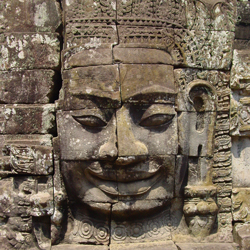 Angkor’ literally means ‘Capital City’ or ‘Holy City’.
‘Khmer’
refers to the dominant ethnic group in modern and ancient Cambodia.
In its modern usage, ‘Angkor’ has come to refer to the capital city
of the Khmer Empire that existed in the area of Cambodia between the
9th and 12th centuries CE, as well as to the empire itself. The
temple ruins in the area of Siem Reap are the remnants of the
Angkorian capitals, and represent the pinnacle of the ancient Khmer
architecture, art and civilization. Angkor’ literally means ‘Capital City’ or ‘Holy City’.
‘Khmer’
refers to the dominant ethnic group in modern and ancient Cambodia.
In its modern usage, ‘Angkor’ has come to refer to the capital city
of the Khmer Empire that existed in the area of Cambodia between the
9th and 12th centuries CE, as well as to the empire itself. The
temple ruins in the area of Siem Reap are the remnants of the
Angkorian capitals, and represent the pinnacle of the ancient Khmer
architecture, art and civilization.
At its height, the Age of Angkor was a time when the capital area
contained more than a million people, when Khmer kings constructed
vast waterworks and grand temples, and when Angkor’s military,
economic and cultural dominance held sway over the area of modern
Cambodia, and much of Thailand, Vietnam and Laos.
|

The First Century: Indianisation
Southeast Asia has been inhabited since the Neolithic era, but the
seeds of Angkorian civilization were sown in the 1st century CE. At
the turn of the millennium, Southeast Asia was becoming a hub in a
vast
commercial trading network that stretched from the Mediterranean to
China. Indian and Chinese traders began arriving in the region in
greater numbers,
exposing the indigenous people to their cultures, though it was
Indian culture that took hold, perhaps through the efforts of
Brahman priests. Indian culture, religion (Hinduism and Buddhism),
law, political theory, science and writing spread through the region
over a period of several centuries, gradually being adopted by
existing states and giving rise to new Indianised princedoms.
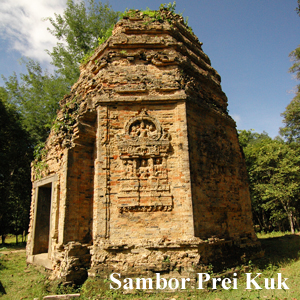 Funan and Chendla: Funan and Chendla:
Pre-Angkor
Though the newly Indianised princely states sometimes encompassed
large areas, they were often no larger than a single fortified city.
They warred among themselves, coalescing over time into a shifting
set of larger states. According to 3rd century Chinese chronicles,
one of China’s principal trading partners and a dominant power in
the region was the Indianised state of Funan centered in today’s
southern Vietnam and Cambodia. There is evidence that the Funanese
spoke Mon-Khmer, strongly indicating a connection to later Angkorian
and Cambodian civilization.
Funan was predominate over its smaller neighboring states, including
the state of Chendla in northern Cambodia. Over the later half of
the 6th century, Funan began to decline, losing its western
territories. Chendla, already in the ascendant, conquered the Khmer
sections of western Funan, while the Mon people won the extreme
western section of Funan in present day Thailand. Later, Chendla
seems to have gone on to conquer the remainder of Funan, signaling
the beginning of the ‘pre-Angkorian’ period. Chendla flourished but
for a short time. The third and last king of a unified Chendla,
Isanavarman I, constructed the pre-Angkorian temples of Sambor Prei
Kuk near modern Kampong Thom city. (If you come to Siem Reap from
Phnom Penh by road, you will pass through Kampong Thom. With a few
spare hours, it is possible to make a side trip to these
pre-Angkorian ruins).
Under Isanavarman I’s successor, Chendla disintegrated into smaller
warring states. It was briefly reunited under Jayavarman I in the
mid-7th century, only to fall apart again after his death. On
traditional accounts, Chendla finally broke into two rival states or
alliances, ‘Land Chendla’ in northern Cambodia/southern Laos, and
‘Water Chendla’ centered further south in Kampong Thom.
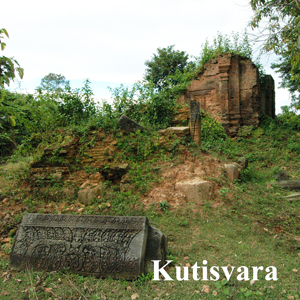 802CE: The Beginning 802CE: The Beginning
Jayavarman II was the first king of the Angkorian era, though his
origins are recorded in history that borders on legend. He is
reputed to have been a Khmer prince, returned to Cambodia around
790CE after a lengthy, perhaps forced stay in the royal court in
Java. Regardless of his origin, he was a warrior who, upon returning
to Cambodia, subdued enough of the competing Khmer states to declare
a sovereign and unified ‘Kambuja’ under a single ruler. He made this
declaration in 802CE in a ceremony on Kulen Mountain (Phnom Kulen)
north of Siem Reap, where he held a ‘god-king’ rite that legitimized
his ‘universal kingship’ through the establishment of a royal
linga-worshiping cult. The linga-cult would remain central to
Angkorian kingship, religion, art and architecture for centuries.
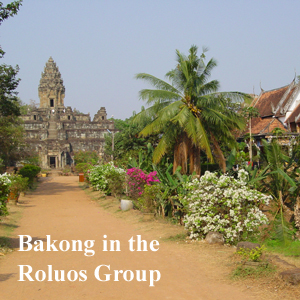 Roluos: Roluos:
The ‘First’ Capital
After 802CE, Jayavarman II continued to pacify rebellious areas and
enlarge his kingdom. Before 802CE, he had briefly based himself at a
pre-Angkorian settlement near the modern town of Roluos (13km
southeast of Siem Reap). For some reason, perhaps due to military
considerations, he moved from the Roluos area to the Kulen
Mountains. Some- time after establishing his kingship in 802CE, he
moved the capital back to the Roluos area, which he named
Hariharalaya in honor of the combined god of Shiva and Vishnu. He
reigned from Hariharalaya until his death in 850CE.
Thirty years after Jayavarman II’s death, King Indravarman III
constructed the temple of Preah Ko, the first major member of the
‘Roluos Group’, in honor of Jayavarman II. He then constructed
Bakong, which was the first grand project to follow the
temple-mountain architectural formula. When visiting these temples,
note the deep, rich, detailed artistic style in the carvings that
were characteristic of the period.
Indravarman III also built the first large baray (water reservoir),
thereby establishing two more defining marks of the Angkorian
kingship - in addition to the linga-cult, the construction of temple
monuments and grand water projects became part of kingly tradition.
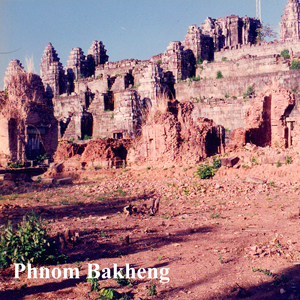 The Capital Moves to Angkor The Capital Moves to Angkor
Indravarman III’s son, Yasovarman I, carried on the tradition of his
father, building the East Baray as well as the last major temple of
the Roluos Group (Lolei), and the first major temple in the Angkor
area (Phnom Bakheng). Upon completing Phnom Bakheng in 893CE, he
moved his capital to the newly named Yasodharapura in the Angkor
area. The move may have been sparked by Yasovarman I’s violent
confrontation with his brother for the throne, which left the Royal
Palace at Roluos in ashes. With one exception, the capital would
reside in the Angkor area for the next 500 years.
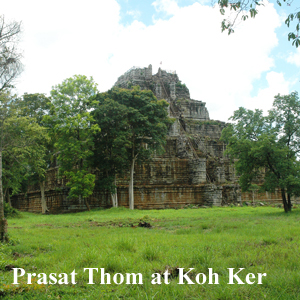 Koh Ker: Koh Ker:
A Brief Interruption
The exception took place in 928CE when, for reasons that remain
unclear, there was a disruption in the royal succession. King
Jayavarman IV moved the capital 100km from Angkor north to Koh Ker,
where it remained for 20 years. When the capital returned to Angkor,
it centered not at Phnom Bakheng as it had before, but further east
at the new state-temple of Pre Rup (961CE).
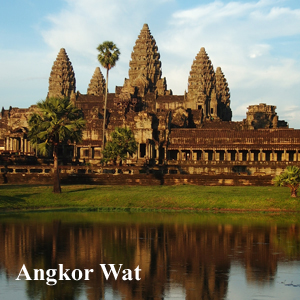 Apogee: Apogee:
The Khmer Empire at Angkor
An era of territorial, political and commercial expansion followed
the return to Angkor. Royal courts flourished and constructed
several major monuments including Ta Keo, Banteay Srey, Baphuon, and
West Baray. Kings of the period exercised their military muscle,
including King Rajendravarman who led successful campaigns against
the eastern enemy of Champa in the mid 10th century. Just after the
turn of the millennium, there was a 9-year period of political
upheaval that ended when King Suryavarman I seized firm control in
1010CE. In the following decades, he led the Khmer to many important
military victories including conquering the Mon Empire to the west
(capturing much of the area of modern Thailand), thereby bringing
the entire western portion of old Funan under Khmer control. A
century later, King Suryavarman II led several successful campaigns
against the Khmer’s traditional eastern enemy, Champa, in central
and southern Vietnam.
Under Suryavarman II in the early 12th century, the empire was at
its political/territorial apex. Appropriate to the greatness of the
times, Suryavarman II produced Angkor’s most spectacular
architectural creation, Angkor Wat, as well as other monuments such
as Thommanon, Banteay Samre and Beng Melea. Angkor Wat was
constructed as Suryavarman II’s state-temple and perhaps as his
funerary temple. Extensive battle scenes from his campaigns against
Champa are recorded in the superb bas-reliefs on the south wall of
Angkor Wat.
By the late 12th century, rebellious states in the provinces,
unsuccessful campaigns against the Vietnamese Tonkin, and internal
conflicts all began to weaken the empire. In 1165, during a
turbulent period when Khmer and Cham princes plotted and fought both
together and against one another, a usurper named
Tribhuvanadityavarman seized power at Angkor.
In 1177 the usurper was killed in one of the worst defeats suffered
by the Khmers at the hands of the Cham. Champa, apparently in
collusion with some Khmer factions, launched a sneak naval attack on
Angkor. A Cham fleet sailed up the Tonle Sap River onto the great
Tonle Sap Lake just south of the capital city. Naval and land
battles ensued in which the city was assaulted, burned and occupied
by the Cham. The south wall of Bayon displays bas-reliefs of a naval
battle, but it is unclear whether it is a depiction of the battle of
1177 or some later battle.
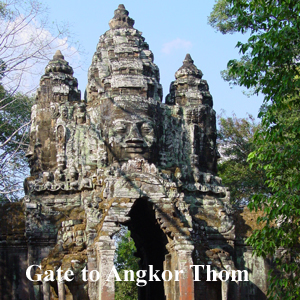 Jayavarman VII: The Monument Builder Jayavarman VII: The Monument Builder
The Cham controlled Angkor for four years until the legendary
Jayavarman VII mounted a series of counter attacks over a period of
years. He drove the Cham from Cambodia in 1181. After the Cham
defeat, Jayavarman VII was declared king. He broke with almost 400
years of tradition and made Mahayana Buddhism the state religion,
and immediately began Angkor’s most prolific period of monument
building.
Jayavarman VII’s building campaign was unprecedented and took place
at a frenetic pace. Hundreds of monuments were constructed in less
than a 40-year period. Jayavarman VII’s works included Bayon with
its famous giant faces, his capital city of Angkor Thom, the temples
of Ta Prohm, Banteay Kdei and Preah Khan, and hundreds of others.
The monuments of this period, though myriad and grand, are often
architecturally confused and artistically inferior to earlier
periods, seemingly due in part to the haste with which they were
rendered.
After a couple of days at the temples, you should begin to recognize
the distinctive Bayon-style of Jayavarman VII’s monuments. Note the
giant stone faces, the cruder carving techniques, simpler lintel
carvings with little or no flourish, the Buddhist themes to the
carvings and the accompanying vandalism of the Buddhas that occurred
in a later period.
At the same time as his building campaign, Jayavarman VII also led
an aggressive military struggle against Champa. In 1190 he captured
the Cham king and brought him to Angkor. In 1203 he annexed all of
Champa, thereby expanding the Khmer Empire to the eastern shores of
southern Vietnam. Through other military adventures he extended the
borders of the empire in all directions.
Jayavarman VII’s prodigious building campaign also represents the
finale of the Khmer empire as no further grand monuments were
constructed after his death in 1220. Construction on some monuments,
notably Bayon, stopped short of completion, probably coinciding with
Jayavarman VII’s death. His successor, Indravarman II continued
construction on some Jayavarman VII monuments with limited success.
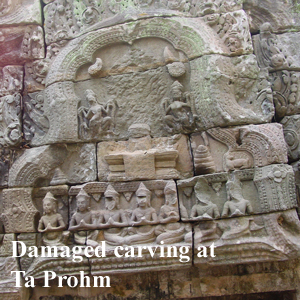 The End of an Era The End of an Era
Though the monument building had come to a halt, the capital
remained active for years. Chinese emissary Zhou Daguan (Chou Ta-Kuan)
visited Angkor in the late 13th century and describes a vibrant city
in his classic, ‘Customs of Cambodia’.
Hinduism made a comeback under Jayavarman VIII in the late 13th
century during which most of Angkor’s Buddhist monuments were
systematically defaced. Look for the chipped out Buddha images on
almost all of Jayavarman VII’s Buddhist monuments. Literally
thousands of Buddha images have been removed in what must have been
a huge investment of destructive effort. Interestingly, some Buddha
images were crudely altered into Hindu lingas and Bodhisattvas.
There are some good examples of altered images at Ta Prohm and Preah
Khan.
Jayavarman VIII also constructed the final Brahmanic monument at
Angkor - the small tower East Prasat Top in Angkor Thom. After
Jayavarman VIII’s death, Buddhism returned to Cambodia but in a
different form. Instead of Mahayana Buddhism, Theravada Buddhism
took hold and remains the dominant religion in Cambodia to this day.
After the 13th century, Angkor suffered repeated invasions by the
Thai from the west, pressuring the Khmer and contributing to the
capital being moved from Angkor. After a seven-month siege on Angkor
in 1431, King Ponhea Yat moved the capital from Angkor to Phnom Penh
in 1432. This move may also have marked a shift from an
agrarian-based economy to a trade based economy, in which a river
junction location like Phnom Penh rather than the inland area of
Angkor would be more advantageous. After the move to Phnom Penh, the
capital of Cambodia moved a couple of more times, first to Lovek and
then Oudong, before finally settling permanently into Phnom Penh in
1866.
After the capital moved from Angkor, the temples remained active,
though their function changed over the years. Angkor Wat was visited
several times by western explorers and missionaries between the 16th
and 19th century, but it is Henri Mouhot who is popularly credited
with the ‘discovery’ of Angkor Wat in 1860. His book, ‘Travels in
Siam, Cambodia, Laos and Annam’ is credited with bringing Angkor
its first tourist boom. .
|

